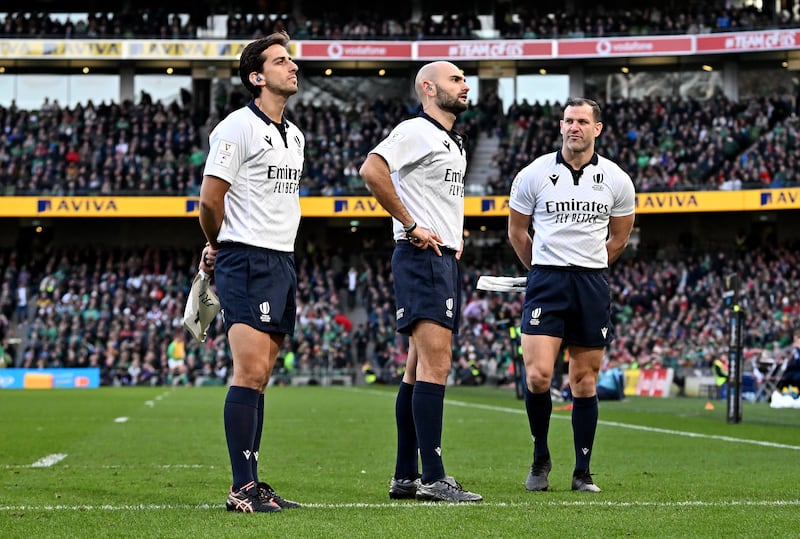World Rugby is considering reducing the tackle height in the elite game as well as a global trial of the 20-minute red card as part of a radical plan to broaden the appeal of the sport.
The governing body will also examine the possibility of reducing the number of replacements and reassess the use of the Television Match Official as it seeks to speed up the game and improve it as a spectacle.
The plan – set to be delivered in five stages – comes on the back of World Rugby’s Shape of the Game forum last month, designed to make the game more entertaining.
More immediate changes include cracking down on the use of water carriers and encouraging referees to call “use it” and ensure scrumhalves play the ball more quickly from rucks. But it is World Rugby’s longer-term proposals that could have a significant impact on the game.
The Counter Ruck: the rugby newsletter from The Irish Times
AIL final preview: History is against both Cork Con and Clontarf but either side could seize the moment
Improved Ireland side can get a much-needed shot of self-belief in Edinburgh
Munster’s discipline deserts them as Cardiff take full advantage of yellow cards
A specialist working group will be established to assess the results of the community tackle height trials across 11 unions and “consider appropriateness for elite rugby”.
When the Rugby Football Union first announced the lowering of the tackle height in early 2023 there was uproar amid mixed messages as to just how far the threshold would be lowered. The trial has passed off far more successfully than its introduction but bringing the change in at elite level would be a seismic change to the professional arm of the sport.
The introduction of a global trial of 20-minute red cards – where the player who is sent off is not allowed to return to the field but is replaced after 20 minutes – will be voted on at World Rugby’s council meeting in May as part of a comprehensive review of disciplinary and sanctioning processes.
It has proved popular in the southern hemisphere and would avoid matches being ruined as a spectacle by debatable red cards, such as that shown to Freddie Steward in England’s defeat by Ireland last year. Opponents of the measure fear that introducing more lenient sanctions amid the ongoing head injury litigation sends the wrong message.
Another working group will also be tasked with looking at research into the impact of fatigue and the number and timing of replacements in the elite game “to determine options that might create more space on the field while improving injury rates”. Eddie Jones is among the senior figures within the game in favour of the reduction of replacements and, more significantly, so too is the World Rugby chairman Bill Beaumont.

World Rugby also wants to overhaul the TMO protocol which has come under widespread criticism for bringing too many lengthy stoppages to the game.
Even as recently as last Saturday there were questions raised about the decision of the TMO to intervene and bring Ben Earl’s no-arms tackle to the referee’s attention – a penalty from which France ultimately scored the winning points to beat England.
World Rugby also wants to look at “setting new minimum standards for technology providers” amid a number of complaints that replays have not been available or shown during the Six Nations. A major review of safety and spectacle issues as they relate to the breakdown will also be conducted by a working group.
From Tuesday, as part of the first phase of the plan, players will be expected to use the ball more quickly when the ball has been secured at a ruck/breakdown. In effect, it is an attempt to bring to an end the dreaded caterpillar ruck. Hookers will also be expected to maintain a full brake foot to aid scrum stability and safety during the engagement sequence while there will be a move to limit the number of times water carriers enter the field of play.
World Rugby has also recommended a number of law changes to be rubber-stamped in May, including the closing of a loophole – known as “Dupont’s Law” – which aims to “reduce kick tennis”. The current relevant law states that players in front of the kicker are adjudged onside once the kick receiver has passed the ball or moved five metres with it. France’s Antoine Dupont has exploited it in the past but doing so leads to lengthy kicking battles. Removing the scrum option from a free-kick at a scrum and outlawing the “croc roll” are also among the amendments to be recommended.
Unions and competition owners will be encouraged to implement a series of closed law trials including using a shot clock for scrums and lineouts, marking the ball inside the 22m line from a restart, insisting the ball must be played after a maul has been stopped once, rather than twice, greater protection for the scrumhalf and allowing the referee to play on if a lineout is not straight if it was not contested.
“The moves that we are making are grounded in our commitment to increasing relevance on a global basis and born from a desire to change for the better,” said Beaumont.
“That means being bold, embracing change by dialling up the entertainment value, making our stars more accessible and simplifying terminology and language used to explain rugby to those who are yet to fall in love with it. We have moved quickly. It has taken a special unity and commitment from across the sport to be able to present a package of enhancements to the council in May. I look forward to the discussions.”















